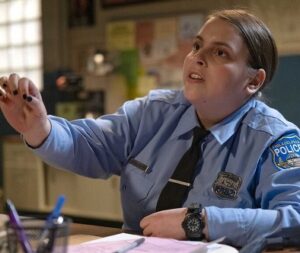Drive-Away Dolls
 Jamie and Marian are friends who decide to take a road trip. To somewhere. To anywhere. You see, Jamie has just broken up with her police officer girlfriend Sukie, and needs to “clear her mind.” Marian would like to visit her aunt in Tallahassee. So, the two young ladies rent a car in Philadelphia, and set out on a road trip.
Jamie and Marian are friends who decide to take a road trip. To somewhere. To anywhere. You see, Jamie has just broken up with her police officer girlfriend Sukie, and needs to “clear her mind.” Marian would like to visit her aunt in Tallahassee. So, the two young ladies rent a car in Philadelphia, and set out on a road trip.
And with this thinnest of plots, director Ethan Coen (working without his brother Joel this time) sets off on what amounts to a high-strung car chase caper, complete with bad guys, a severed head, and an accidentally stolen briefcase. (And unlike in “Pulp Fiction,” this time we do get to see inside the briefcase – although we really don’t want to know; it’s a long story.)
Familiar set-up
“Drive-Away Dolls” plays out like much of the Coens’ earlier work, like their hilarious 1987 comedy “Raising Arizona,” albeit without the tender side that endeared us to the two leads. We knew they were criminals, but we sympathized with their inability to conceive. Here, we have no strong connection to the leads, and that’s what prevents “Drive-Away Dolls” from being mentioned in the same breath as many of the Coens’ avant-garde classics. Still, this one is a funny romp, although I’d be surprised if it makes any critics’ Top Ten lists next December.
The leads
Margaret Qualley’s Jamie is perhaps the most in-your-face lesbian character ever to grace the screen. She’s the type who eagerly discusses artificial sexual aids at a fancy restaurant… As the waiter is pouring her champagne! Marian is also a lesbian, but far more reserved. Jamie’s idea of a fun evening is visiting the local lesbian bar to find a one-night stand; Marian’s is staying home to read four more chapters of a Henry James novel. The two could not be more mismatched. And of course, that’s part of the fun.
As Marian, Geraldine Viswanathan practically steals the show. Her bookworm shtick is over-the-top as written (by Coen and his wife, film editor and screenwriter Tricia Cooke), but she plays the role so endearingly that we sympathize with her at the expense of the loud, brash, and more dimwitted Jamie. Furthermore, in flashbacks we learn young Marian was infatuated with her often naked next-door neighbor – whose yard was fenced in, but Marian had made a hole. Marian is looking for a long-term relationship, as opposed to Jamie’s constant prowling for one-nighters.
Additional plot developments
Now, since this is a Coen film, there must be more to the plot than simply two young ladies on a road trip, right? Correct! For you see, Jamie and Marian rent a car from a local driveaway car service named Curly’s – and Curly is played by a brilliantly understated Bill Camp, who is in fact so dry and phlegmatic it’s a wonder the Coens haven’t used him previously. Due to a mix-up in cars, the girls head out for Florida with a car containing a mysterious briefcase in the trunk – as well as a severed head in a duffel bag. Again, it’s a long story.
Chasing the girls are two bad guys who “need” the head and the briefcase. And this is where Coen’s and Cooke’s original screenplay shines. Rather than writing these characters as stock hit man types and relegating their screentime to the occasional “check in with them” scenes, these two become major characters and hold our interest in what amounts to a fairly flimsy set-up with the girls.
The hit men
Played by C.J. Wilson and the very amusing Joey Slotnick, the bad guys’ banter is almost on a par with that of Jeff Bridges and Gil Birmingham in “Hell or High Water.” Wilson’s Flint is the stereotype tough guy, who garners all the information he needs via threats and physical violence. Slotnick’s Arliss is the more touchy-feely type, who instantly befriends others to glean information. During their alone time in their car, Slotnick berates Wilson for his outdated methods, and the result is some of the most clever writing to come along in a while.
 And Beanie Feldstein turns in a marvelous supporting performance as Jamie’s recent ex-girlfriend. She’s a cop who takes her work very seriously. She’s funny enough in the early scenes to warrant her reappearance during the final act. Coen is too sharp to write such a strong character and leave her out of the climax.
And Beanie Feldstein turns in a marvelous supporting performance as Jamie’s recent ex-girlfriend. She’s a cop who takes her work very seriously. She’s funny enough in the early scenes to warrant her reappearance during the final act. Coen is too sharp to write such a strong character and leave her out of the climax.
No cell phones
Coen and Cooke have set “Drive-Away Dolls” in 1999, seemingly for no other reason than people didn’t have cell phones back then, which makes it difficult for the hit men to accurately chase the girls. They must rely on tracing recent credit card purchases and actual interaction with others to trace the girls’ progress. There are a few references to Y2K, but again, much of the plot is necessitated by the time period.
When both parties finally arrive in Florida, they meet up in a funny, satisfying conclusion which doesn’t necessarily leave us longing for anything, save for the aforementioned lack of personal attachment to any of the lead characters. Marian comes closest to warranting our affinity, but not the way Nicholas Cage and Holly Hunter did in “Raising Arizona.”
Mixed bag
As with much of the Coens’ recent work, “Drive-Away Dolls” is a mixed bag. Yes, there are some very funny moments. But some of it needs to be fine-tuned. Think “Hail, Caesar!” or the episodic Western anthology “The Ballad of Buster Scruggs.” Just once, I’d like to love a Coen film all the way through, from start to finish, the way I did with “No Country for Old Men,” “Fargo,” “Raising Arizona,” or “Blood Simple.” The Coens (together or separately) are two of our most talented and original filmmakers. If “Drive-Away Dolls” were their first film, I’d say they have a very bright future. Coming toward the end of their career – They’ll each turn 70 within the next four years – they should be churning out better work than this.
Andy Ray‘s reviews also appear on https://townepost.com/.